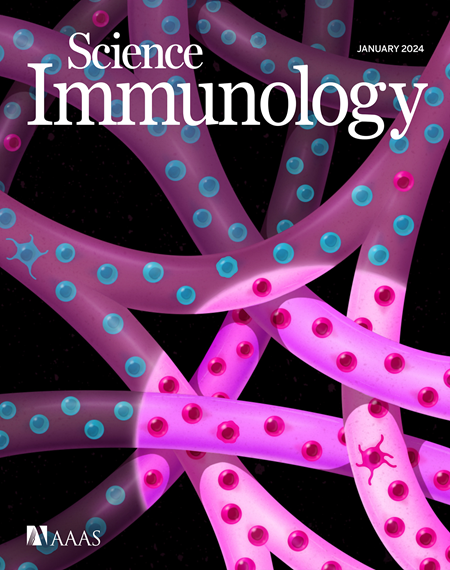Protein palmitoylation and sphingolipid metabolism control regulated exocytosis in cytotoxic lymphocytes
IF 16.3
1区 医学
Q1 IMMUNOLOGY
引用次数: 0
Abstract
Regulated exocytosis controls key cellular functions ranging from neurotransmitter release to the secretion of immune mediators, and its disruption is associated with numerous pathologies. The cytotoxic activity of lymphocytes is particularly dependent on regulated and polarized lytic granule delivery toward infected or malignant cells. Although genetic and mechanistic studies have identified factors regulating exocytosis in cytotoxic lymphocytes, a systematic mapping of the relevant factors and their relationships is lacking. Through a genome-scale CRISPR knockout screen in a human natural killer cell line, we characterized a complex genetic network regulating cytotoxic granule exocytosis, with lipid metabolism and protein lipidation among the most prominent pathways. By combining global protein palmitoylation and lipidomic studies, we found that ZDHHC17 drives palmitoylation of the core SNARE complex protein SNAP23 to target cytotoxic granules to GM1-rich lipid rafts whose assembly is controlled by serine palmitoyltransferase. In summary, our study identifies previously unrecognized factors essential for cytotoxic function in human lymphocytes and uncovers how lipid metabolism and protein palmitoylation are involved in the process of regulated exocytosis.
蛋白棕榈酰化和鞘脂代谢控制细胞毒性淋巴细胞的胞吐
调节胞吐控制关键的细胞功能,从神经递质释放到免疫介质的分泌,其破坏与许多病理有关。淋巴细胞的细胞毒性活性特别依赖于对感染细胞或恶性细胞的调节和极化裂解颗粒的递送。虽然遗传和机制研究已经确定了细胞毒性淋巴细胞中调节胞吐的因素,但缺乏相关因素及其关系的系统映射。通过在人类自然杀伤细胞系中进行基因组规模的CRISPR敲除筛选,我们表征了一个调节细胞毒性颗粒胞吐的复杂遗传网络,其中脂质代谢和蛋白质脂化是最突出的途径。通过结合全球蛋白棕榈酰化和脂质组学研究,我们发现ZDHHC17驱动核心SNARE复合物蛋白SNAP23的棕榈酰化,将细胞毒性颗粒靶向富含gm1的脂筏,其组装由丝氨酸棕榈酰转移酶控制。总之,我们的研究发现了以前未被认识到的人类淋巴细胞细胞毒性功能的必要因素,并揭示了脂质代谢和蛋白棕榈酰化如何参与调节的胞吐过程。
本文章由计算机程序翻译,如有差异,请以英文原文为准。
求助全文
约1分钟内获得全文
求助全文
来源期刊

Science Immunology
Immunology and Microbiology-Immunology
CiteScore
32.90
自引率
2.00%
发文量
183
期刊介绍:
Science Immunology is a peer-reviewed journal that publishes original research articles in the field of immunology. The journal encourages the submission of research findings from all areas of immunology, including studies on innate and adaptive immunity, immune cell development and differentiation, immunogenomics, systems immunology, structural immunology, antigen presentation, immunometabolism, and mucosal immunology. Additionally, the journal covers research on immune contributions to health and disease, such as host defense, inflammation, cancer immunology, autoimmunity, allergy, transplantation, and immunodeficiency. Science Immunology maintains the same high-quality standard as other journals in the Science family and aims to facilitate understanding of the immune system by showcasing innovative advances in immunology research from all organisms and model systems, including humans.
 求助内容:
求助内容: 应助结果提醒方式:
应助结果提醒方式:


